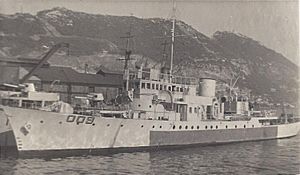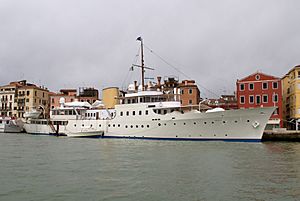HMS Evadne facts for kids

HMS Evadne at Gibraltar
|
|
Quick facts for kids History |
|
|---|---|
| Name |
|
| Namesake | Evadne |
| Owner |
|
| Builder | Camper and Nicholsons, Southampton |
| Yard number | 388 |
| Launched | February 1931 |
| Completed | 1931 |
| Identification |
|
| Name | Evadne |
| Commissioned | September 1939 |
| Identification | FY 009 |
| Fate | Returned to civil use as a yacht |
| Name | Marala |
| Identification |
|
| General characteristics | |
| Type | Armed yacht |
| Displacement | 581 tons |
| Length | 58.83 m (193 ft 0 in) |
| Beam | 8.08 m (26 ft 6 in) |
| Draught | 3.35 m (11 ft 0 in) |
| Propulsion | Two 8cyl MAN 750 bhp (560kw) diesel engines |
| Speed | 15.5 knots (28.7 km/h; 17.8 mph) |
| Complement | 45 |
| Armament |
|
HMS Evadne (FY 009) was a converted yacht, commissioned as a warship by the Royal Navy during the Second World War. She survives today as the yacht Marala.
Contents
Yacht Evadne
The Evadne was a large twin-screw motor yacht, built in 1931 by Camper and Nicholsons at Southampton, England as Yard Number 388. She was originally building for the automobile and aircraft engine manufacturer Montague Napier, but he died in January 1931, before she had been named. She was launched in February 1931. Still known as 388, she ran trials in June and was subsequently registered at Southampton with that name, and official number 161735. In December 1931 the yacht was sold for £50,000 to Richard Fairey, of Fairey Aviation and later renamed Evadne.
Hired by the Admiralty in September 1939, she was refitted in England as an anti-submarine vessel and commissioned as HMS Evadne.
Irish Sea
Based in Liverpool initially, she carried out patrols and other duties in the Irish Sea. In 1940 she was fitted out as an anti-submarine vessel at the Grayson Rollo shipyard. Subsequently she was employed on examination service duties at Holyhead and escorting convoys in the Irish Sea, from bases at Holyhead, Milford Haven and Liverpool.
Bermuda
In July 1942 Evadne joined the Highlander escort group to escort a convoy across the Atlantic before breaking away to Bermuda, where she was employed on anti-submarine duties at the Royal Naval Dockyard (Evadne operated outside of Bermuda's barrier reef, leaving the enclosed waters to HMS Castle Harbour, then HMS Sumar).
Gibraltar
Evadne remained in Bermuda until being reallocated to the Commander-in-Chief Mediterranean, arriving on 12 March 1944 in Gibraltar, where she was based until hostilities ended.
On 19 February 1945, she badly damaged German U-boat U-300 with depth charges in the Strait of Gibraltar, in position 35°54′N 05°43′W / 35.900°N 5.717°W. The U-boat was subsequently sunk on 22 February in the North Atlantic west of Cadiz, in position 36°29′N 08°20′W / 36.483°N 8.333°W, by gunfire from the British minesweepers HMS Recruit and HMS Pincher. Nine of the 50 crew were lost.

Evadne arrived back in Portsmouth on 6 September 1945 and was paid off the following month.
Return to yachting
Following the war, Evadne returned to civil life as a yacht. By September 1950 she had been sold to a private British company, renamed Zapala for the use of the American businessman R. J. Reynolds Jr., of the eponymous tobacco company, initially for a world cruise. Reynolds owned Sapelo Island on the Atlantic coast of Georgia, known by Spanish colonists as Zapala.
The yacht operates today in the Mediterranean, under the name MY Marala, still with her original engines.
On film
The Evadne (now Marala) was the setting of the 2001 film The Cat's Meow, in which she represented William Randolph Hearst's yacht, the Oneida.
External links

